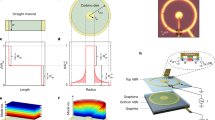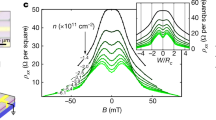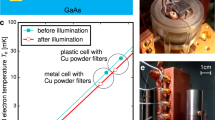Abstract
Semiconductor nanostructures based on two-dimensional electron gases (2DEGs) could form the basis of future devices for sensing, information processing and quantum computation. Although electron transport in 2DEG nanostructures has been well studied, and many remarkable phenomena have already been discovered (for example, weak localization, quantum chaos, universal conductance fluctuations1,2), fundamental aspects of the electron flow through these structures have so far not been clarified. However, it has recently become possible to image current directly through 2DEG devices using scanning probe microscope techniques3,4,5,6,7,8,9,10,11,12,13. Here, we use such a technique to observe electron flow through a narrow constriction in a 2DEG—a quantum point contact. The images show that the electron flow from the point contact forms narrow, branching strands instead of smoothly spreading fans. Our theoretical study of this flow indicates that this branching of current flux is due to focusing of the electron paths by ripples in the background potential. The strands are decorated by interference fringes separated by half the Fermi wavelength, indicating the persistence of quantum mechanical phase coherence in the electron flow. These findings may have important implications for a better understanding of electron transport in 2DEGs and for the design of future nanostructure devices.
This is a preview of subscription content, access via your institution
Access options
Subscribe to this journal
Receive 51 print issues and online access
$199.00 per year
only $3.90 per issue
Buy this article
- Purchase on Springer Link
- Instant access to full article PDF
Prices may be subject to local taxes which are calculated during checkout




Similar content being viewed by others
References
Beenakker, C. W. J. & van Houten, H. in Solid State Physics (eds Ehrenreich, H. & Turnbull, D.) 44, 1–228 (Academic, New York, 1991).
Sohn, L. L., Kouwenhoven, L. P. & Schon, G. Mesoscopic Electron Transport in Semiconductor Nanostructures (Kluwer Academic, Boston, 1997).
Topinka, M. A. et al. Imaging coherent electron flow from a quantum point contact. Science 289, 2323–2326 (2000).
Eriksson, M. A. et al. Cryogenic scanning probe characterization of semiconductor nanostructures. Appl. Phys. Lett. 69, 671–673 (1996).
Crook, R., Smith, C. G., Simmons, M. Y. & Ritchie, D. A. Imaging cyclotron orbits and scattering sites in a high-mobility two-dimensional electron gas. Phys. Rev. B 62, 5174–5178 (2000).
Crook, R. et al. Imaging diffraction-limited electronic collimation from a non-equilibrium one-dimensional ballistic constriction. J. Phys. Cond. Matter 12, L167–L172 (2000).
McCormick, K. L. et al. Scanned potential microscopy of edge and bulk currents in the quantum Hall regime. Phys. Rev. B 59, 4654–4657 (1999).
Zhitenev, N. B. et al. Imaging of localized electronic states in the quantum Hall regime. Nature 404, 473–476 (2000).
Finkelstein, G., Glicofridis, P. I., Ashoori, R. C. & Shayegan, M. Topographic mapping of the quantum Hall liquid using a few-electron bubble. Science 289, 90–94 (2000).
Manoharan, H. C., Lutz, C. P. & Eigler, D. M. Quantum mirages formed by coherent projection of electronic structure. Nature 403, 512–515 (2000).
Jamneala, T., Madhavan, V., Chen, W. & Crommie, M. F. Scanning tunneling spectroscopy of transition-metal impurities at the surface of gold. Phys. Rev. B 61, 9990–9993 (2000).
Yoo, M. J. et al. Scanning single-electron transistor microscopy: imaging individual charges. Science 276, 579–582 (1997).
Gurevich, L., Canali, L. & Kouwenhoven, L. P. Scanning gate spectroscopy on nanoclusters. Appl. Phys. Lett. 76, 384–386 (2000).
Grill, R. & Döhler, G. H. Effect of charged donor correlation and Wigner liquid formation on the transport properties of a two-dimensional electron gas in modulation delta-doped heterojunctions. Phys. Rev. B 59, 10769–10777 (1999).
Davies, J. H. The Physics of Low-Dimensional Semiconductors: An Introduction (Cambridge Univ. Press, New York, 1998).
Wolfson, M. A. & Tomsovic, S. On the stability of long-range sound propagation through a structured ocean. At http://xxx.lanl.gov/abs/nlin.CD/0002030 (2000).
Eriksson, M. A. et al. Effect of a charged scanned probe microscope tip on a subsurface electron gas. Superlattices Microstruct. 20, 435–440 (1996).
Altshuler, B. L., Aronov, A. G. & Khmelnitsky, D. E. Effects of electron-electron collisions with small energy transfers on quantum localisation. J. Phys. C 15, 7367–7386 (1982).
Acknowledgements
This work was supported in part at Harvard University by the Office of Naval Research/Augmentation Awards for Science and Engineering Research Training (ONR/AASERT), by ONR and by the National Science Foundation through grants for the Materials Research Science and Engineering Center and for the Institute for Theoretical Atomic and Molecular Physics at Harvard University and Smithsonian Astrophysical Observatory. Work at the University of California Santa Barbara was supported by the NSF Science and Technology Center QUEST.
Author information
Authors and Affiliations
Corresponding author
Rights and permissions
About this article
Cite this article
Topinka, M., LeRoy, B., Westervelt, R. et al. Coherent branched flow in a two-dimensional electron gas. Nature 410, 183–186 (2001). https://doi.org/10.1038/35065553
Received:
Accepted:
Issue Date:
DOI: https://doi.org/10.1038/35065553
This article is cited by
-
Electrical tuning of branched flow of light
Nature Communications (2024)
-
Branched flows of flexural waves in non-uniform elastic plates
Communications Physics (2022)
-
Effects of Lead-Device Interfaces on Transport Properties in a Two-Terminal 2DEG System
Journal of Electronic Materials (2021)
-
A new model for explanation and generation of branched flow of light
Applied Physics B (2021)
-
Observation of branched flow of light
Nature (2020)
Comments
By submitting a comment you agree to abide by our Terms and Community Guidelines. If you find something abusive or that does not comply with our terms or guidelines please flag it as inappropriate.



